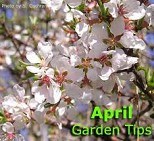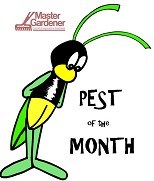Posted 9/6/2012
by Joanna Beckerman, Department of Botany and Plant Pathology, Purdue University
When confronted with a disease, many homeowners say they prefer to use organic products because they are more environmentally friendly. Others say they just want to use a product that works, regardless of the ecological impact. Many organic fungicide products can satisfy the needs of both groups in one container, providing effective control with minimal ecological impact. However, improperly using any chemical (organic or otherwise) will result in poor control and may harm non-target organisms. This article offers strategies for properly using organic fungicides and describes various kinds of these products.
Plant Health Management
Effectively using organic fungicides (or any fungicide for that matter) requires a solid plant health management strategy.
Be Certain Before You Spray
Before applying any pesticide, you must properly diagnose the problem before implementing any management program.
Sulfur – can be a preventive fungicide against powdery mildew, rose black spot, rusts and other diseases.
Copper – several cooper fungicide formulations are available to organic growers. Regardless of the formulation, cooper fungicides effectively kill both fungi and bacteria.
Oils – the most frequent use of oils is to manage insects. However, oils effectively manage powdery mildew on many plants but are significantly less effective against other leaf spot diseases.
Horticulture Oils - Mineral oils are a type of refined petroleum product and horticultural oils are mineral oils distilled to remove impurities that can damage plants. The final formulations combine these oils with an emulsifying agent that allows the oil to mix with water.
Bicarbonates - recent research demonstrated that although baking soda (sodium bicarbonate) can be effective against plant diseases when used with oil, its sodium component could build up and become toxic to plants.
Conclusion - managing plant disease problems during rainy seasons is a challenge. Successfully managing these problems organically requires carefully choosing the right plants, properly planting and maintaining them and quickly diagnosing any problems correctly before you apply any chemical.
Click below to read the complete article.
Posted 9/4/2012
As the nights cool down it is time to bring houseplants that have been enjoying the summer season outdoors back inside.
Before re-introducing them into the house, rinse them off thoroughly to get rid of any insects that may be lingering. A soil drench may also be used if cutworms, sow bugs or ants are present in pots.
Change the fertilizer to half strength and stop feeding completely by mid October. Leaf drop on your plants may occur as the plant acclimates to the lower light and humidity conditions inside the house. Do not panic and overwater. Overwatering is the number one killer of houseplants.
Posted 8/16/2012
by Dr. Francis W. Holmes, retired director of the UMass Shade Tree Lab

-During droughts, trees sometimes shed up to 10% of their leaves. This benefits a tree under special drought conditions because it then loses less water into the air. Loss of this much food-making capacity does little or no harm.
-Vigorous trees may make too many leaves. This excess may suddenly drop in mid-June as a natural adjustment to summer heat and lower soil moisture. Such ‘physiological leaf-drop’ does these trees no harm.
-Trees’ inner leaves and twigs, which were shaded-out by the upper, outer leaves, normally die for lack of sunlight. They drop off, leaving large branches bare near the trunk. This is normal, nor harmful.
-A whole tree may be shaded out by an over-towering tree and then die, or two adjoining trees may mutually shade out the sides that face each other. So long as both trees remain, this may look okay but if one tree then dies, the other has only dead branches to show on that side.
-Individual leaves may fall when shaded out by a dense crust of dark fungi called ‘sooty molds’. These grow on the sugary excretions of aphids. Once the aphids are killed, the sooty molds weather away and finally vanish.
-Leaves may fall because an insect tunneled into the leafstalk (e.g. maple petiole borer), with only a very short piece of petiole remaining on the leaf blade. This affects little foliage and does no harm. It stops each year about two weeks after it begins. No spray is needed.
-Leaves fall, of course, after attacks of fatal diseases like Dutch elm disease, or a sudden devastating injury like girdling the trunk, cutting off many roots, or freezing the roots in a bare winter. Here, it’s too late to do anything by the time the leaves are falling. On the other hand, slow attacks – over several years – even by a fatal disease like root rot or a gradual fatal injury, like smothering from fill or pavement or compaction or flooding (be it of water or gas) usually leads to more and more dead branches in the tree top and to smaller leaves. But not to an abrupt leaf fall.
-Leaves fall after local infection by certain leaf-spot disease fungi. In the individual infected leaves, pseudo-hormones trigger autumn-like abscission. Even if ALL the leaves fell (rare), a single attack would not be fatal to a broad-leaved tree. In so severe a case, a fungicide should be used the next spring, as leaves open, to be sure the tree isn’t weakened by repeated attacks. Leaf spots are most abundant after rainy springs.
-Chemical injury: effects depend on what chemical, what season, what temperature, what tree species, etc. Some chemicals discolor leaves but the leaves don’t fall. Some cause leaf fall but do not hurt the rest of the tree (new leaves come out). Others kill trees. Once such leaves fall, it’s too late. There is no treatment.
-Clusters of fallen leaves, attached to short twigs, result from a twig-girdling insect or squirrel activity. If the former, a shallow depression encircles the broken twig end just inside the bark. If the latter, the break is diagonal and may have two or three small ‘steps’. These are rarely any threat.
Garden Clippings, volume 30, #6, August 2010
Posted 8/13/2012

Do you remember catching toads as a child? Most likely the toad you caught was Bufo americanus - the American toad. It is one of the most common amphibians found throughout the United States. American toads breed in ponds and wetlands in the spring and lay strings of eggs in the water. After hatching, the newborns spend a few weeks as tadpoles, and then emerge from the water as adorable baby toads. Adult toads spend most of their life away from water and are most active at dusk and on drizzly days. Take a walk at dusk to do a toad inventory – you might be surprised to find that toads already reside in your backyard.
Why should we care about toads? While they may look short, squat, slow and generally unworthy of attention, toads will stalk and eat unwanted garden pests. Their tongues dart out to catch flying insects faster than our eyes can follow. One of their favorite meals is the cutworm, that nasty garden demolition expert. Toads can also add a beautiful song to your world. Did you know that all toads and frosts (the toad’s more water loving relative) have a different song to communicate within their species, just like birds do? Go outside on a warm spring night and listen. That is when you will hear toads singing a high-pitched monotone trill to delineate territories and attract mates.
Ponds and natural wet spots attract toads. Toads seek dim, moist spots during the day. Something as simple as a broken clay pot, placed on its side like a cave, works well for a toad shelter. Garden centers offer attractive toad homes if you want something more stylish for your amphibian guests. You may want to create a small pond or wetland in your backyard.
If you want to give toads an advantage in your yard, reevaluate the chemical fertilizers and herbicides yo use. Some amphibian deformities have been traced to overexposure to certain chemicals. In general, amphibians are having a hard time surviving because of habitat degradation and loss.
But don’t give toads a hard time about warts. The glands behind a toad’s eyes are not warts, nor can they give you warts. Those glands secrete a toxin and they are a toad’s best defense against predators such as cats and dogs. The toxin irritates the mouths of would-be diners.
Maintaining a natural balance in the backyard is difficult. Amphibians should be considered when trying to achieve balance. Toads can live for several years. Given the right habitat, once they move into your neighborhood toads are likely to stay for years to come. Support a toad; it may turn out to be a different kind of prince in your natural kingdom.
Source, USDA, NRCS, Reprinted from Chautauqua Living, Aug. 2004
Posted 8/7/2012
There's lots to do for your vegetable garden, flower plot, lawn, and containers! Check out this list to have a great late summer garden.
Posted 7/31/2012
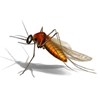
With the dry conditions we have been experiencing here in the Mohawk Valley this summer, you may not have had to contend with many mosquitoes while outdoors. Now that the precipitation is beginning to appear, you might want to think about preventing mosquito infestations where it is possible.
Are you a mosquito magnet? Perhaps it is because you smell so good! Mosquitoes are attracted by their victim’s scent, chemicals in their perspiration, heat and carbon dioxide.
The red bump and itching of a mosquito bite is caused by an allergic reaction to the saliva of a female mosquito which contains proteins that prevent your blood from clotting. After the female mosquito gets her fill of blood (male mosquitoes do not bite), she lays her eggs and the life cycle begins again.
Mosquitoes can transmit diseases through their bite such as malaria, dengue fever and several forms of encephalitis, including West Nile virus. Not only can mosquitoes carry diseases that afflict humans but they also can transmit several diseases and parasites to which dogs and horses are very susceptible. These include dog heartworms and eastern equine encephalitis and West Nice Virus. (EPA.gov).
Rarely, someone may have a severe allergic reaction to mosquito bites, resulting in swelling in the throat, significant hives and wheezing, requiring immediate medical attention. Also, if a mosquito bit seems to be associated with more serious signs and symptoms – such as fever, severe headache, body aches, nausea and vomiting – contact your doctor. (mayoclinic.com)
Below are some mosquito control tips from the Environmental Protection Agency. You will also find information about the safe use of insect repellents, pesticides for mosquitoes and other helpful resources on their web website, http://www.epa.gov/opp00001/health/mosquitoes/control.htm.
- Eliminate standing water in rain gutters, old tires, buckets, plastic covers, toys or any other container where mosquitoes can breed.
- Empty and change the water in bird baths, fountains, wading pools, rain barrels and potted plant trays at least once a week to destroy potential mosquitoes habitats.
- Drain or fill temporary pools of water with soil
- Keep swimming pool water treated and circulating.
Also consider using bacillus granules in your rain barrels that destroy mosquito larvae.
Courtesy “Update, Summer 2009”
Posted 7/26/2012
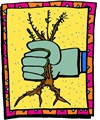
Most annual weed seeds are tiny - often about the size of the head of a pin. Because their food stores are small, they cannot emerge from deep in the soil, and they are very thin and fragile shortly after germination. Hence very shallow (~ 1") disturbance of the soil can be very effective for eliminating a large percentage of these weeds. Deeper soil disturbance brings additional seeds to the surface where they will germinate.
If planting has been delayed since the seedbed was prepared, scratch the soil surface thoroughly with a garden rake or stirrup hoe before planting. Repeat when the first tiny seedlings appear. For large seeded crops like sweet corn, beans etc. that are planted >1" deep, the soil can be raked right over the rows before the crop emerges, and if you are careful, after the shoots are fully out of the ground. Since you can't see the weeds, these actions often seem pointless. They are easy to perform, however, and they are probably the single most effective way to reduce difficult pulling and hoeing later in the season.
Posted 7/24/2012
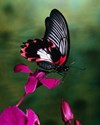
Hosting Caterpillars
In order to host butterflies each summer, it’s imperative the garden offers food plants for the spring and summer caterpillars that will morph into those butterflies. It must also contain host plants for the larvae. Each species has a specific food plant or family of plants upon which they feed. Most of the caterpillars of familiar butterflies feed on trees or on plants that are categorized as weeds. By allowing some border areas to remain natural we can easily provide necessary food plants for the future butterflies.For example, a number of small wild cherry (Prunus) seedlings will provide food for the caterpillars that will be reborn as red spotted purples. Elm (Ulmus) and hackberry (Celtis) seedlings also offer a food source. Their fresh growth will attract red spotted purple butterflies to lay eggs on them.Many herbs are excellent food sources for caterpillars. Female black swallowtails lay eggs on parsley, fennel, dill and rue (Ruta graveolens). Giant swallowtail larvae also feed on rue. Orange, swamp and tropical milkweeds (Asclepias) attract female monarch butterflies to lay eggs; their caterpillars will feed on them.
Feeding Butterflies
Adult butterflies require nectar plants for food to give them the energy necessary for flight. Though many flowers contain nectar for butterflies, there are a few superstar performers. In late August, a lush butterfly bush (Buddleia davidii), full of blossoms attracts monarchs. Butterfly bush is available in a variety of colors, provides dozens of fragrant blooms from July through fall and is the queen of all nectar plants. It’s a must for the butterfly garden.The butterfly garden should also include the tough, drought-tolerant bloom of the coneflower (Echinacea purpurea), with cultivars of many colors. It will invite the great spangled fritillary. Drought-tolerant Brazilian verbena (Verbena bonariensis) brings grace to the garden with its long-stemmed purple flowers. Cut it back after the first wave of flowers to encourage rebloom later in the season. Many types of butterflies enjoy this overlooked super performer.
To invite eager swarms of butterflies into your yard, plant butterfly milkweed (Asclepias tuberosa). It’s easily grown from seed. And don’t forget the familiar zinnia (Zinnia angustifolia). It’s a favorite for butterflies of all types, and it gives our garden a much-needed dose of wonderful late-summer color.
Posted 7/19/2012

Many perennials lose their good looks after their flowers have faded. They often develop a tattered, ragged appearance as the leaves on the flowering stems turn yellow or brown. Just removing the spent flower heads isn’t enough. To really keep your garden looking its best after flowering you need to do more aggressive pruning. This encourages new shoots of attractive, healthy leaves to grow from the base of the plant.
Not all plants fade after flowering. Some have attractive seed pods life the Siberian iris and others like Echinacea (coneflower) produce seeds that the birds love.
But most perennials look much better if given a good pruning after flowering. Delphinium will almost always reward you with a second flower show in late summer if you remove the flower stalks as soon as they fade but most other perennials bloom just once a season.
Before you begin cutting, take a good look at a perennial that’s finished flowering. Push the old flower stalks gently aside and see if you can see any new shoots beginning to emerge near the base of the plants.
If you see the new shoots, you can prune without hesitation. Once the old, dominating flower stalks are removed, the new shoots will be free to expand and grow. The plant might look a little bare after you prune it but those new shoots will fill in very quickly. The new shoots will strengthen the root system of the plant and produce food to be stored for next year so you definitely want to encourage them.
Source: Amy Ivy, Executive Director, CCE Clinton County, NY. Courtesy of Town & Country, 2008.
Posted 7/17/2012

Most flowers benefit from a flower preservative which usually contains three ingredients: citric acid, sugar and a bactericide. Citric acid is used to lower the pH for optimum water uptake. It has been shown that low pH water (pH=3.5) travels faster in the stem, thereby preventing or reducing wilting. Carbohydrates (sugar) are needed for food although the optimum concentration of sugar varies significantly depending on the flowers being treated. Most flowers benefit from a continuous supply of 2% sugar in the vase solution. Some flowers, such as Gladioli, have been shown to benefit from higher concentrations, such as a four to six percent sugar solution. Other flowers such as Zinnias and Coralbells, sustain damage when treated with concentration of sugars higher than 1%. Still others, such as Chrysanthemums and China Asters, do well without any sugar in the keeping solution. A 1% sugar solution is approximately equal to dissolving two level teaspoons of sugar into a quart of water The third ingredient is a bactericide such as a bleach solution to inhibit the growth of bacteria on the cut flower stems.
When arranging flowers in their final vase, cut the stems again and use a preservative in the water. Here are two recipes for a general flower preservative that contain all three ingredients:
- One can non-diet citrus soda (Sprite or 7-Up) plus three cans of water and 1.2 ml of household bleach (use a dropper)
OR
- Two tablespoons of fresh lime or lemon juice, one tablespoon of sugar, half a tablespoon of b leach and one quart of water.
Flowers harvested in the summer have a longer vase life than those harvested in the fall. To encourage sure satisfactory vase life, preservative solution containing sugar is necessary for flowers that are harvested at the end of the growing season.
Tina Smith, Extension Specialist UMass Extension Floriculture Program. Excerpt from Harvesting and Caring for Cut Flowers. Source: Garden Clippings, volume 29, #6, August 2009







